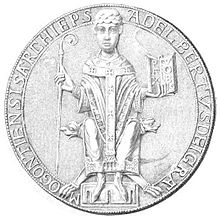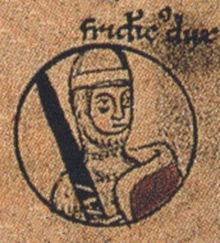1125 German royal election

The 1125 German royal election was the
.Sources
The events during the election are preserved in most detail in the Narratio de electione Lotharii Saxoniae ducis in regem Romanorum (Account of the Election of Lothair of Saxony as King of the Romans), which was written by an unknown eye-witness, probably a monk at Göttweig Abbey, where the manuscript of the text was found. The manuscript was produced in the middle of the 12th century and thus at least twenty-five years after the events it describes. The detailed content of the account and the author's unawareness of the conflict between Lothair and the Staufen brothers Frederick II and Conrad III indicates that the original text was written before the end of 1125 and that the surviving manuscript must be a copy of it.[1] Further accounts of events during the election are provided by the Orderic Vitalis and Otto of Freising.
Background

Archbishop Adalbert, advisor of the last
Henry V died on 23 May 1125. His will left his personal property to his nephew Duke Frederick II von Staufen of Swabia, but placed the
Candidates

The electoral system chosen by Adalbert was a recent innovation, first used in the election of the Abbot of Zwiefalten Abbey in 1095, which was called the Electio per compromissum (Election through compromise), in which there would be ten candidates from each of the provinces of Bavaria, Swabia, Franconia, and Saxony and they would all have to reach an agreement on a single candidate.[6] The forty electors obviously could not agree, but three candidates were put forward:
- Frederick II, Duke of Swabia,
- Lothair III, Duke of Saxony, and
- Leopold III, Margrave of Austria
Otto von Freising records a fourth candidate,
Frederick, as nephew, supporter and personal heir of the last Salian emperor could claim the strongest right to the throne and was considered the favourite. But the powerful Duke Lothair had significant support, as a long-term opponent of the Salian emperors' hostile policy toward the spiritual princes of the empire. Leopold of Austria was also linked to the Salian dynasty, since his wife Agnes of Waiblingen was a daughter of Henry IV, and he enjoyed the support of the southern German clergy.[8]
Course of the election
Frederick, who was encamped outside the city of Mainz, did not immediately appear at the electoral assembly. After the three candidates had been named, Adalbert went to Lothair and Leopold to ask if either of them was willing to recognise one of the other candidates as king. Both agreed and simultaneously announced their renunciation of their candidature.[9] In this way, they showed their humility and demonstrated that they were worthy of being elected as king.[10] According to the Narratio, Frederick believed that as a result of this announcement by the other two candidates, he was the only candidate remaining. The following day he entered the city victoriously, expecting to be elected by the assembled princes.
After Frederick's arrival, Adalbert repeated the question he had asked the previous day to each candidate, but when he came to Frederick he also asked whether he was willing to renounce the designation of a successor in order to enable free elections in future. Frederick left this question unanswered and went back to his camp to consult with his associates, thereby resigning as a candidate.
Subsequently, Lothair's followers riotously proclaimed him king and called on the inhabitants of the city who were assembled outside to celebrate the new king. Although many of the Bavarian princes protested at the elevation of Lothair to the kingship without an election and were demanding that an actual vote take place, Adalbert barred the doors to prevent the people of Mainz from acclaiming Lothair and to prevent the Bavarian princes from holding the vote. Then one of the Papal legates in attendance called for quiet and the Bavarian bishops declared that they could not reach a decision without Henry the Black, their Duke, who had left the assembly at the same time as Frederick II.
Perhaps three days later,[11] the electors gathered once more and Lothair was elected king by the princes, including Henry the Black, who was present this time.[12] The princes then performed homage to the new king. Frederick II finally did homage two days later and Archbishop Frederick of Cologne crowned Lothair in Aachen on 13 September. Conflict had already broken out between the king and Frederick II by the end of the year.[13]
References
- ^ Heinz Stoob, "Zur Königswahl Lothars von Sachsen im Jahre 1125," Historische Forschungen für Walter Schlesinger, edited by Helmut Beumann, Köln/Wien 1974, p. 444.
- ^ Wolfgang Petke, Kanzlei, Kapelle und Königliche Kurie unter Lothar III. (1125–1137), Beihefte zu J. F. Böhmer, Regesta Imperii. Bd. 5, Köln/Wien 1985, p. 273.
- ^ Wolfgang Petke, Kanzlei, Kapelle und Königliche Kurie unter Lothar III. (1125–1137), Beihefte zu J. F. Böhmer, Regesta Imperii. Bd. 5, Köln/Wien 1985, pp. 278–279.
- ^ Otto von Freising, Gesta Frederici seu rectius cronica / Die Taten Friedrichs oder richtiger Cronica, edited by Franz-Josef Schmale, 2nd edition, Darmstadt 1965, p. 156; Ekkehard von Aura, Frutolfi et Ekkehardi chronica necnon anonymi chronica imperatorum / Frutolfs und Ekkehards Chroniken und die anonyme Kaiserchronik, translated and edited by Franz-Josef Schmale and Irene Schmale-Ott, Darmstadt 1972, p. 374.
- ^ Otto von Freising, Gesta Frederici seu rectius cronica / Die Taten Friedrichs oder richtiger Cronica, edited by Franz-Josef Schmale, 2nd edition, Darmstadt 1965, p. 156; Ordericus Vitalis, The ecclesiastical history of Orderdic Vitalis. Books XI, XII and XIII, edited by Marjorie Chibnall, Oxford 1978, pp. 360/362.
- ^ Narratio de electione Lotharii Saxoniae ducis in regem Romanorum, edited by Wilhelm Wattenbach, MGH. SS XII, Hannover 1856, p. 510.
- ^ Otto von Freising, Chronica sive historia de duabus civitatibus / Chronik oder die Geschichte der zwei Staaten, hrsg. von Walther Lammers, 3. unv. Aufl., Darmstadt 1974, p. 528.
- ^ Ulrich Schmidt, Königswahl und Thronfolge im 12. Jahrhundert, Köln/Wien 1987, p. 43.
- ^ Narratio de electione Lotharii Saxoniae ducis in regem Romanorum, edited by Wilhelm Wattenbach, MGH. SS XII, Hannover 1856, p. 510.
- ^ Ludwig Vones, "Der gescheiterte Königsmacher. Erzbischof Adalbert I. von Mainz und die Wahl von 1125," Historisches Jahrbuch 115 (1995), pp. 101–102.
- ^ Ulrich Nonn, "Geblütsrecht, Wahlrecht, Königswahl: Die Wahl Lothars von Supplinburg 1125," Geschichte in Wissenschaft und Unterricht 44 (1993), p. 156.
- ^ Narratio de electione Lotharii Saxoniae ducis in regem Romanorum, edited by Wilhelm Wattenbach, MGH. SS XII, Hannover 1856, pp. 510–511.
- ^ Bernd Schneidmüller, "1125 – Unruhe als politische Kraft im mittelalterlichen Reich," in Staufer & Welfen. Zwei rivalisierende Dynastien im Hochmittelalter, edited by Werner Hechberger, Regensburg 2009, S. 30–49, hier S. 41.
Bibliography
Primary
- Narratio de electione Lotharii Saxoniae ducis in regem Romanorum, edited by Wilhelm Wattenbach, MGH. SS XII, Hannover 1856, pp. 509–512. Online (accessed on 13 April 2017)
- Ordericus Vitalis, The Ecclesiastical History of Orderic Vitalis. Books XI, XII and XIII, edited by Marjorie Chibnall, Oxford 1978, pp. 360–367.
- Otto von Freising, Gesta Frederici seu rectius cronica / Die Taten Friedrichs oder richtiger Cronica, edited by Franz-Josef Schmale, 2nd edition, Darmstadt 1965, pp. 156–159.
- Registers and other sources on the election: RI IV,1,1 n. 92, in Regesta Imperii Online (accessed on 12 March 2013)
Secondary
- Hermann Kalbfuß, "Zur Entstehung der »Narratio de electione Lotharii«," Mitteilungen des Instituts für österreichische Geschichtsforschung 31 (1910), pp. 538–557.
- Ulrich Nonn, "Geblütsrecht, Wahlrecht, Königswahl: Die Wahl Lothars von Supplinburg 1125," Geschichte in Wissenschaft und Unterricht 44 (1993), pp. 146–157.
- Ulrich Schmidt, Königswahl und Thronfolge im 12. Jahrhundert, Köln/Wien 1987, ISBN 3-412-04087-8.
- ISBN 978-3-7917-2168-2.
- ISBN 3-412-10474-4.
- ISSN 0018-2621.
External links
- Excerpt of the Narratio de electione Lotharii. "digitalised image". Photograph Archive of Old Original Documents (Lichtbildarchiv älterer Originalurkunden). University of Marburg.
